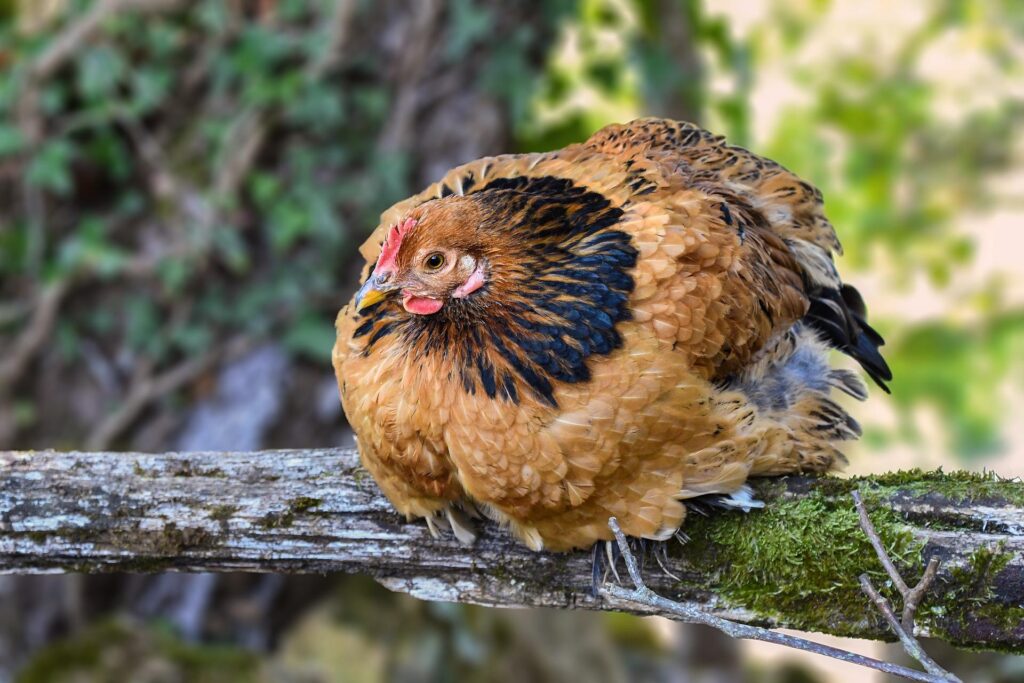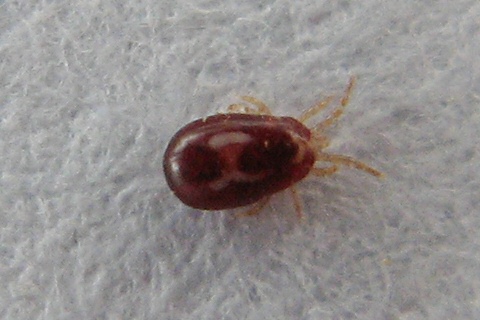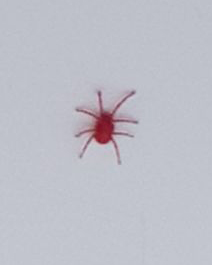
What are Red Mite?
Red mites are tiny eight-legged ectoparasites which hide in the dark cracks and crevices of chicken coops during the day and emerge during the warmer nights between May and October to feed on the blood of chickens while they’re asleep.
What do Red Mite look like?
Before feeding, red mites are a translucent light grey colour, which changes to a distinctive red/brown colour after they’ve fed.
Unfortunately, due to their small size, roughly 0.6mm to 1mm long, red mites are nearly invisible to the naked eye and most chicken owners don’t tend to notice them until they have already grown into a large infestation which can take a few weeks to properly get rid of.

Signs you may have red mite
Your chickens refuse to go to bed at night to avoid being bitten. Instead, they try to roost in the run or if they are free-ranging they may try to roost anywhere high up they can reach such as on top of sheds or even in trees!
Your girls may start laying eggs in random places such as the floor of the coop or run to avoid red mites hiding in their nest box. If they become too stressed they may stop laying altogether
Your chickens’ comb, wattles and eyelids start looking paler than usual due to the blood loss
Your chickens look lethargic and have started sitting hunched up in a corner half asleep, rather than scratching around and being their usual happy selves
Your chickens may become aggressive toward each other and start feather pecking due to the stress of being bitten
Sadly, the worst sign of a red mite infestation is the death of one or more of your chickens. This is usually the chicken at the bottom of the pecking order as she will be forced to sleep closest to the infestation by the others.
How do I check for red mites in my chicken coop?
While red mites like to hide in the dark crevices of your chicken coop during the day, the best time to check for them is at night when your girls have gone to bed.
If you shine a torch where your girls are roosting you should see hundreds of red mites swarming over the perch and walls trying to get to your poor chickens for a feed.
Wipe a piece of white kitchen roll along the underside of the perch your girls are roosting on. If you have red mites which have recently fed, you will see little red streaks where you’ve squashed them on the kitchen roll.
Another way to confirm is to remove the perch during the day and check the ends. If you have red mites they will usually be found hiding in the crevice where the perch meets the wall.
How do I get rid of Red Mite? How do I kill Red Mite Naturally?
Personally, if you have a wooden chicken coop with a felt roof the quickest and easiest way to deal with a red mite infestation is to move your chickens to a plastic coop and burn the old one to the ground!
We won’t judge you if you happen to be laughing maniacally, shouting ‘die red mite, die!’ although you might get a few strange looks from your neighbours.
On a more serious note, I’d definitely recommend getting rid of your wooden chicken coop and replacing it with a plastic one such as the omlet eglu or converting a plastic Keter shed into a coop.
If you’re not able to get a plastic coop right now and decide to keep your wooden coop, you’ll want to choose a day when you can give yourself a good few hours to work on getting rid of the red mite, as you want to make sure you’re not rushing and are able to get rid of as many of the little pests as possible.
What you’ll need:
A pressure washer – I’d recommend using an electric one, but a handpump one should work at short notice
Old clothes – I’d recommend wearing something you won’t mind getting wet and probably covered in red mite!
Gardening gloves
A face mask
Scrubbing brush
Smite or Poultry Shield
Ondulin/bitumen Roof Panels – A Plastic Tarp will work as a short term solution if you have one to hand
Fresh bedding
Diatomaceous Earth
1 – Strip down your chicken coop as much as possible
Take your chickens out of the coop. You might want to wait till later in the day when they’ve finished laying but if you have a moody broody you will need to ‘encourage’ her out
Remove all the bedding from your coop and nest box and make sure to seal the bedding in bin bags. You don’t want any red mites finding their way back to your coop and starting all over again later on!
Strip the house down as much as you can. Removing or unscrewing perches, ramps, the nest box, and any other part that will unscrew easily. You want to uncover as many joins as possible so the red mites have nowhere to hide
If you have a felt roof, you will need to remove and destroy it. I recommend replacing it with bitumen sheeting so there are no spaces for the red mite to hide.
2 – Wash and scrub your chicken coop
Once you have broken your coop down soak any remaining cracks and crevices with Poultry Shield or Smite.
Wait for 10-20 minutes to really let the cleaner soak in. This will disturb the red mite and start removing their waxy outer coating, forcing them out of the cracks.
After 20 minutes, wash the house and parts you removed with a pressure washer from top to bottom. Make sure to get into every crack and crevice possible so you don’t miss any red mite or eggs.
Tip: Angle the pressure washer spray wand down at a 45-degree angle to reduce the chances of getting soaked and covered in red mite.
If you don’t have a pressure washer, you can use a scrubbing brush to scrub the coop from top to bottom, making sure to get into all the gaps as deep as possible.
3 – Wait for your chicken coop to dry
Wait for the coop to dry for 10- 20 minutes. When you check back you should see more red mites which have been disturbed crawling around. These were the ones who were missed earlier.
4 – Rinse and Repeat
Soak the cracks and crevices with Poultry Shield or Smite again, and wait another 10-20 minutes. Then pressure wash or scrub from top to bottom making sure to get right into the cracks again.
Repeat 3-4 times, until you can’t see any red mite. Remember the more you remove the better, as a small amount can very quickly turn back into a large infestation.
5 – Rebuild your chicken coop
Once your chicken coop is free of red mites, pop everything back together
Replace any felt roofs with ondulin roof panels. A plastic tarp will work if need be, but make sure to stretch it tight and secure it as best you can so it can’t flap in the wind and scare your chickens.
Add fresh bedding and mix in a few handfuls of Diatomaceous Earth, a 500g tub should roughly cover a 1m x 1m or 3ft x 3ft space. You might also want to use bedding with Eucalyptus added as another natural deterrent.
Rub some more Diatomaceous Earth into each perch, making sure to get into the gaps at the ends and underneath. The perch should look white when you are finished. I’d recommend wearing gardening gloves or using a scrubbing brush to get it fully coated and avoid splinters
6 – Aftercare
Check your chicken coop over the next few days. If after 5-6 days you can still see quite a few red mites you will need to strip the coop down and repeat the cleaning process again as you don’t want to give any remaining red mites the chance to lay eggs and start the process over again.
Add Smite Organic Oblitermite to your chickens’ drinking water to get rid of any red mites which might have been missed or are newly hatched. The Oblitermite stimulates your chickens’ blood to create its own natural toxins as an immune response which then kills any red mite when they try to feed on your chickens. Plus because it is made from 100% natural ingredients there is no egg withdrawal period.
If your girls are looking pale or unwell after a red mite attack, you can give your chickens a vitamin boost and build up their iron levels with a red mite rescue remedy such as Agrivite Poultry Mite Rescue Remedy
You can also use Diatomaceous Earth or red mite powder on your girls so any red mites which crawl onto them die but be extra careful not to get any in their eyes or nostrils.
Check your girls’ perch at least once a week, with a piece of kitchen roll or tissue when they go to bed especially between May and October, to make sure the infestation isn’t starting over again from any missed eggs
Top up the perches with Diatomaceous Earth every 2-3 days as it wears off, and spray the ends of the perches with Poultry Shield or Smite until there are no more red mites
Remember, between May and October red mite eggs can change into adults in less than a week! You need to keep treating and cleaning out your chickens every 2-3 days to break the red mite life cycle. It may seem like a lot of hard work but it will be worth it, in the end, to see your girls back to being happy.
How to prevent Red Mites
If you have a wooden coop I would strongly recommend changing it to a plastic one. While plastic coops can still get red mite infestations they provide fewer places for the red mite to hide so it’s much easier to spot them before they become a serious problem. Plus they are much quicker and easier to clean. Just pop the doors open, take the perches and ramp out and spray it down with the pressure washer
Replace any felt roofs on your coop or run with bitumen or clear plastic sheeting. As there are no layers, there will be fewer places for the red mite to hide.
Seal any cracks and crevices with food-grade silicone sealant to reduce red mite hiding places
Keep your chicken coop clean
Add garlic probiotics to your chickens’ food. This works as a natural deterrent as red mites don’t like the taste of garlic in your chickens’ blood
Use Poultry Shield or Smite each time you clean your chickens’ coop to make sure any new red mites are quickly gotten rid of
Frequently Asked Questions
I’ve found loads of tiny red bugs in my garden and on my bins and window sills! Are these Red Mite?
Don’t worry, if you’ve spotted a lot of tiny red bugs running around your garden during the day they are more likely to be red spider mites after your plants than red mites, as red mites hate daylight.
The easiest way to tell the difference is red mites are oval-shaped with most of their legs at the front, and red spider mites are more rounded with their legs along the sides like a spider.
Red spider mites are also a bright red colour whereas red mites are a translucent grey colour, and at first glance are often confused for dust or ash until they feed, at which point they change to a dark reddish-brown color.


How long can red mite survive?
Red mites can live 6 to 8 months without feeding! Worse still, red mite eggs can survive up to 2 years waiting for the right conditions to hatch!
Are red mites harmful to humans?
Although red mites won’t drink human blood, they can bite you which can cause skin irritation. If you do get red mite on you, throw your clothes in the wash and hop in the shower. The soap and detergent will wash away the red mites’ waxy outer coating and kill them.
Can red mites live on dogs?
Red mites can only drink blood from chickens and other birds so they won’t feed on your dog but may bite them causing skin irritation and scratching. Remove them using dog shampoo and rinsing with warm water.
Where do red mite come from?
In the wild red mite live inside the bark of trees waiting for a bird to roost nearby. At night they crawl onto the unsuspecting bird for a feed and any red mite that are still on the bird when it takes flight in the morning will be taken to a new location.
Second-hand chicken coops – remember adults can survive 6-8 months without feeding, and eggs can wait up to 2 years for the right hatching conditions, so just because a coop has been in someone’s garage for a few months doesn’t mean it is necessarily red mite free!
New chickens you add to your flock may bring red mites with them from their previous home. Quarantine new additions for a few weeks before introducing them to your flock.
People cuddling chickens on petting farms may unknowingly bring red mites back with them on their clothes or hands.
Are Red mites dangerous? Will Red Mites Kill Chickens?
While red mites are not particularly dangerous to humans, they can be deadly for your poor chickens! They will just keep drinking your chickens’ blood until your poor chicken dies from blood loss!
How does Diatomaceous Earth work on Red Mites?
Diatomaceous Earth, DE or DesiDust is a natural product that has millions of tiny sharp edges. When the red mites crawl through the Diatomaceous Earth these sharp edges scratch away the red mites’ waxy outer shell, causing them to dry out and die!
Can Red Mites Jump or Fly?
You’ll be happy to hear that thankfully no Red Mites can’t jump or fly. They have short stubby legs and no wings so they are only able to crawl.
When is Red Mite season?
Red mites are most active between 10-35C (50-95F) which is why they usually become a problem between May and October. As the weather gets colder the red mite will stop laying eggs at 9C (48F) but will continue to be active and feed on your chickens. When the temperature drops below 5C (41F) they will go into hibernation.
